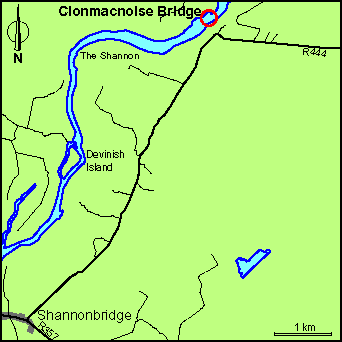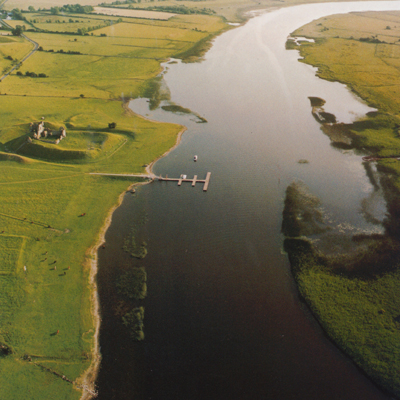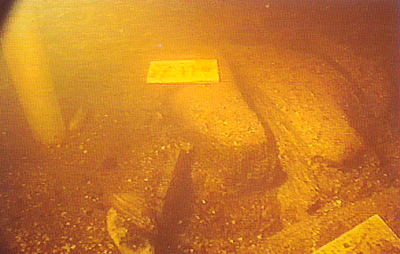|
Clonmacnoise Bridge
by: Aidan O’Sullivan and Donal Boland

Fig.12.4.1: Location map of Clonmacnoise
Bridge, Co. Offaly [OSI]
The early medieval wooden bridge at Clonmacnoise (Fig. 12.4.1) crosses the
River Shannon immediately downstream of the monastic site (Plate 12.4.1) and is
visible underwater today as a double row of eroded wooden posts at water depths
of 1.5-5m. The site was first discovered in 1994 by two local divers (Donal
Boland and Mattie Grehan). In 1995, a preliminary site survey was carried out by
the Irish Underwater Archaeological Research Team (IUART). In 1997 and 1998, a
detailed site survey and excavation was carried out by Aidan O’Sullivan and
Donal Boland (Management for Archaeology Underwater Ltd.) for the National
Monuments Service (formally Dúchas) and dendrochronological dates were obtained
from the School of Palaeoecology and Archaeology, Queen’s University Belfast,
indicating that the structure was built c. 804 AD.

Plate 12.4.1: Aerial view looking
south-west, Clonmacnoise Bridge, Co. Offaly [National Monuments Service]

Plate 12.4.2: Underwater photo showing
timbers, Clonmacnoise Bridge, Co. Offaly [Donal Boland]
The early medieval wooden bridge was located on a shallow and relatively
narrow part of the river, but owing to the exceptional depth and softness of the
riverbed clays there, it could never have served as a natural fording place.
While it is likely that this was a long-term crossing point for boats, it was
crossed by a bridge structure for only a brief period. While its proximity to
the monastic site explains its location, it is also significant that the bridge
was approached on both sides by more long-distance route ways, the Slí Mhór
to the east and a bog trackway in Coolumber to the west.
The bridge measured c.120m in length and 4-5m in width. A line of narrow,
vertical hazel and alder poles was first driven into the riverbed to mark out
its proposed location. The main bridge structure was then constructed of a
double row of vertical oak posts, 4-5m apart. The bridge consisted of c.
25 pairs of these posts, spaced at c. 4-6m intervals going across the
river, of which 17 survived. Underwater excavations revealed that the vertical
posts were prevented from sinking into the riverbed by a simple, but ingenious
method of individual base-plates, beams and planks (Plate 12.4.2) This could be
reconstructed from the single vertical post excavated and extracted from the
riverbed. This was driven to a depth of 3.5m into the soft clays. It had been
crudely sharpened to a blunt point with augur holes drilled through the tip. It
had a through-mortise cut through its side (3.5m from the tip). This snugly held
a transverse oak beam; itself mortised at either end. Each of these mortises
also a held broad, cleft oak plank. As the post descended into the riverbed,
this arrangement of planks prevented it from sinking too far and allowed it to
stand without swaying. Similar features on most of the other vertical posts
indicate that this technique was used right across the river. The superstructure
of the bridge has long been destroyed by collapse and riverine erosion and many
timbers may have been robbed out soon after its abandonment. It is unlikely
however, that it stood much higher than 6m above the riverbed, with a walkway of
hurdles, poles or planks supported on a superstructure of jointed beams.
Comparative studies of early medieval bridges in northern Europe and
ethnological parallels of more recent wooden bridges suggest that the
Clonmacnoise bridge would not have had a life span of much more than 40-50
years.
The underwater surveys and excavations also uncovered a number of associated
finds. This includes eleven dugout boats, some of which were found beside the
bridge timbers. Remarkably, three of these boats contained early medieval
woodworking tools, including felling and carpentry axes and a whetstone. These
tools may well have been lost during the bridge construction project. Another
find on the riverbed beside the bridge included a rare eighth/ninth century
copper-alloy basin, similar to examples found previously in the early medieval
Derrynaflan hoard and in Derreen, Co. Clare. This is a type of vessel that was
probably used in the church liturgy, for holding wine or washing of the hands.
Its location on the riverbed could be explained by its accidental loss or by its
violent removal from the monastery during a raid. Alternatively, the vessel may
have been deliberately thrown into the river (it bears damage from a sharp
object) for some as yet poorly understood reason. Other finds include a
prehistoric chert core, an iron dish, wooden objects, animal bone and quantities
of iron slag eroded into the river from probable early medieval ironworking
sites along the riverbank.
The early medieval bridge at Clonmacnoise should be interpreted in the
context of local and regional social and political developments in the Irish
midlands in the early ninth century AD. It may have been constructed to enable
the growing monastic population to travel easily back and forth to their
agricultural estates on the west side of the river, or to enable pilgrims to
come easily to the monastery. Alternatively, the bridge may have been
constructed through royal patronage, as part of the aggressive political and
military expansion of Connacht kings during the period. It can also be
understood as a single event in the long-term history of travel across the River
Shannon.
Note: The Clonmacnoise bridge project will be published in 2004 as
O’Sullivan, A. and Boland, D. The early medieval bridge at Clonmacnoise:
Underwater archaeological investigations, 1994-1998. Clonmacnoise
Studies, Vol. 3, National Monuments Service.
References
Boland, D. 1996 ‘Clonmacnoise’, In I. Bennett (ed.), Excavations 1995.
Wordwell Ltd, Bray.
Boland, D. and O’Sullivan, A. 1997 ‘An early medieval wooden bridge at
Clonmacnoise’, In F.J.G. Mitchell and C. Delaney (eds.), The Quaternary of
the Irish Midlands. Field Guide 21, Irish Association for Quaternary
Studies, Dublin, 14-21.
O’Sullivan, A. and Boland, D. 1998 ‘Clonmacnoise’, In I. Bennett (ed.),
Excavations 1997. Wordwell, Bray, 148-49.
O’Sullivan, A. and Boland, D. 1998 ‘Medieval Irish engineers bridge the
River Shannon’, Discovering Archaeology 1, 32-37.
O’Sullivan, A. and Boland, D. 2000 The Clonmacnoise bridge: An early
medieval river crossing in County Offaly. Archaeology Ireland Heritage
Guide No. 11. Wordwell, Bray.
O’Sullivan, A., Brady, N. and Boland, D. 2000 ‘Clonmacnoise’, In I. Bennett
(ed.), Excavations 1998. Wordwell, Bray, 174.
This website was originally
developed by
Charles Camp for
CIVL
1101.
This site is
Maintained by the
Department of Civil Engineering
at the University of Memphis.
Your comments and questions are welcomed.
|



